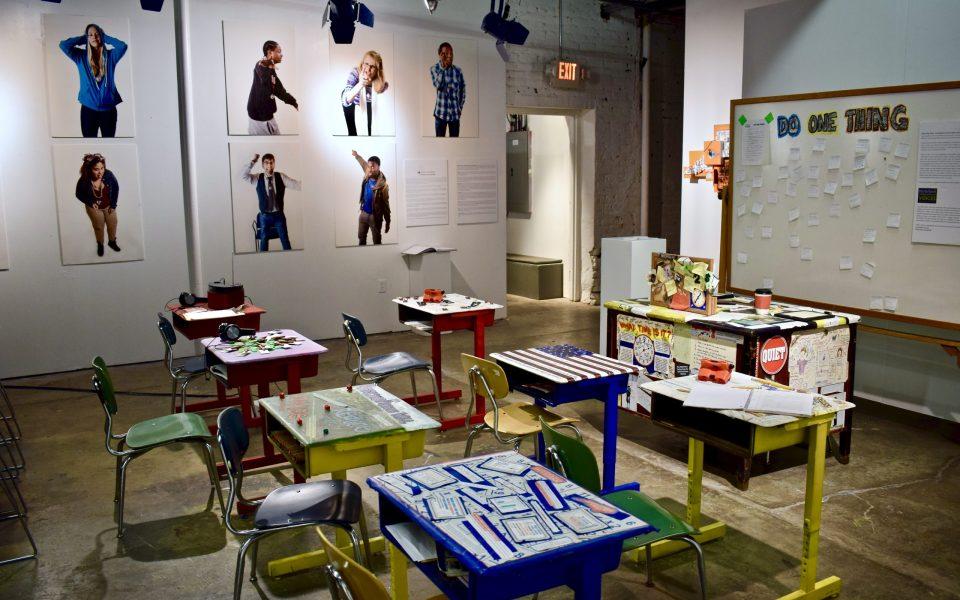A sea of vertical portrait photographs — a teacher wagging a finger, students sullen and jubilant — envelop the growing crowd, two rows of school desks and a teacher’s model. Notebooks lined with real students’ stories sit inside. Collages of statistics and poetry decorate the desktops.
This scene rests in the Greensboro Project Space which hosts None of the Above: Dismantling the School to Prison Pipelines, an interactive exhibit that is the outcome of Hidden Voices’ 3-year collaborative multimedia project exploring race, poverty and incarceration through the lens of education policy in North Carolina. The evening of Oct. 26, Greensboro locals wove performance art into the exhibit as they embodied students, teachers, parents, school resource officers, advocates, community organizers, defense attorneys and incarcerated people during a series of monologues in front of an intimate audience. Hidden Voices’ founder and director Lynden Harris wrote the scripts based on scores of interviews with North Carolinians in more than 20 counties.
They spoke of long-term suspensions and “zero tolerance” policies, directing funds to police officers instead of school counselors. Some voluntary actors are more comfortable wielding the mic than others, more artful in their delivery, but each display certainty in their moral righteousness. A defense attorney’s monologue mournfully decries these practices as “terrorism against young people, an assault on the bodies, minds and spirits of the very kids who are most vulnerable in the first place.”
In 2016, African-American children represented only 25 percent of the population below age 18 but were subjected to 49 percent of delinquency complaints and 63 percent of detention center admissions, according to the Southern Coalition for Social Justice. Numbers tell but a fraction of the story.
“There’s money attached to keeping people uneducated,” a black mother’s monologue says. “Some of the same people up high making decisions… they’ve got ties to companies making orange suits for prisoners. Ties to security companies…. You want to talk about gangs? They’re gangs. They’ve got their own little system and they write their own rules. So, what I wanna know is who’s gonna fix the gangs at the top?”
Change, especially institutional change, is slow and shaky but there are signs of progress. As of December 2019, the state will cease automatically charging 16- and 17-year-olds as adults; until then North Carolina still has the lowest age of juvenile court jurisdiction among all states that specify a minimum age. Six-year-olds can still be tried in delinquency court for “disorderly conduct.”
“There’s nobody wealthy getting prosecuted,” an attorney says. “It’s poor kids. It’s overwhelmingly children of color. Our courts are a dumping grounds for social problems that if you have means are going to be dealt with in some other way.”
According to KidsCount Data Center, approximately 1 in 4 North Carolina children live in poverty and half live in low-income households. Jennifer Feather, a UNCG English professor, takes on the role of a legal aid attorney who underlines the United States’ long history of withholding education to preserve a white supremacist socioeconomic caste system.
“People talk about the school-to-prison pipeline like it’s a new phenomenon,” she says. “Really it’s a new phrase for a 400-year-old problem.”
A desk in the front row of the installation’s “classroom” ties her arguments to tangible, contemporary realities. Miniscule plastic infants’ backs are super-glued to the desk’s surface among a storm of individual testimonies, research findings and juvenile disorderly conduct petitions filled in with infractions or which real North Carolina students faced legal consequence: firing a spitball, bumping into a teacher, pulling an arm out of the principal’s grasp and missing the trash can. One paper cutout reads: “In one North Carolina county, 6.6% of white students were suspended for first-time dress code offenses as compared to 38.3% of black students.” The use of infants also serves to remind viewers that 13-year-olds are more child than adult and implies that these students’ fates were somewhat sealed upon birth into a certain racial caste.
“We live in a society that’s very punish-oriented,” a juvenile justice staffer says. “Why? Because that’s easier than looking at our own roles in how the system got set up. By punishing someone, we disconnect them from everyone and drive them away. It sends the message: ‘You don’t belong here,’ and that’s a terrible message to send to a young person. If all you have is a hammer, every child will look like a nail.”
After the performance attendees mosey through the exhibit, then out into a cold drizzle, and the classroom quiets on its last evening in town. The mouths of cold metalloid desks whisper: How many more stories do we need?
Join the First Amendment Society, a membership that goes directly to funding TCB‘s newsroom.
We believe that reporting can save the world.
The TCB First Amendment Society recognizes the vital role of a free, unfettered press with a bundling of local experiences designed to build community, and unique engagements with our newsroom that will help you understand, and shape, local journalism’s critical role in uplifting the people in our cities.
All revenue goes directly into the newsroom as reporters’ salaries and freelance commissions.


Leave a Reply